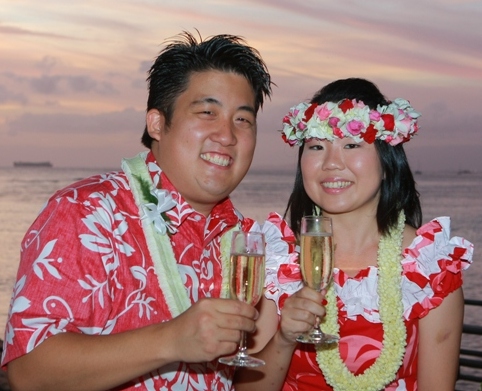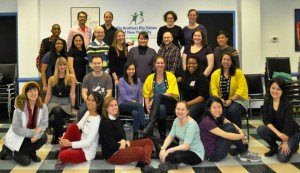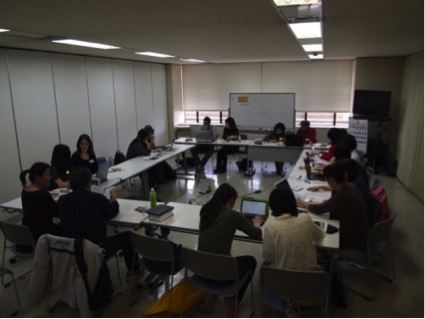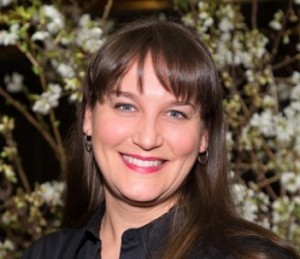CLAIR Magazine “JET Plaza” Series: Patricia Bader-Johnston (Yokohama)
Each month, current and former JET participants are featured in the “JET Plaza” section of the CLAIR Forum magazine. The June 2014 edition includes an article by JET alumnus Patricia Bader-Johnston. Posted by Celine Castex (Chiba-ken, 2006-11), currently programme coordinator at CLAIR Tokyo.
***********
Patricia Bader-Johnston (Yokohama-shi, 1989-91) was one of the first CIRs on the JET Programme. She currently is the Representative Director and CEO of Silverbirch Associates K.K; and is a retained Advisor to Tokyo Business Development Center, as well as a Partner in Thurlestone Capital (a leading clean energy investment firm in the UK). Before founding Silverbirch Associates in 2008, Ms. Bader-Johnston held senior roles in leading companies including Goldman Sachs, BAT and IBM, over a span of 25 years in Japan. She is an active speaker, writer, panel moderator and university lecturer on topics related to CSR and sustainability, globalization trends, and doing business in Japan.

Patricia Bader-Johnston emceeing the Entreprepreneur Business Awards Ceremony 2013 (courtesy of Ms. Bader-Johnston)
I was a CIR in Yokohama City government between 1989 and 1991. It was the year of YES 89, an international expo involving over 60 countries that ran throughout that first year, and set the tone for many of the experiences I had in my early days in Yokohama. It also no doubt helped set a path for my future career in Communications. Working as a member of Yokohama City Hall – City pin in my lapel and all – I not only received the gift of a Key to the City when I left, but also a host of memories and formative experiences that remain with me to this day.
I had already been in Japan for two years before becoming one of four of Canada’s first CIR’s on the (then) brand new and completely unknown JET programme. Because the program was so new, we no doubt benefited from a fair amount of attention and special care in that first year. I had a chance to personally interview Prime Minister Nakasone a few years after I left the programme, and he told me how JET had been meant to emulate the US Peace Corps. He had wanted to bring young foreigners into Japan to “cause positive friction” to force Japanese to internationalize more quickly. He called this programme “Kokusaika.”
In order to have the foreigners live in the country long enough to create this “friction”, they needed to be given something to do over a longer term, so they came up with two types of jobs descriptions: the AET to influence educators and young people, and the CIR to influence local governments.
As a CIR I was exposed to many various experiences that ranged from working in the International Press Center for YES 89 to assisting at UN conferences. I mc’ed an ASEAN conference, interpreted for the Crown Prince and Prime Minister Kaifu when they met the International Director of the Red Cross, helped play host to numerous foreign delegations that ranged from the Vice President of the United States to the Mayor of Vancouver Canada and the Vancouver City Police Pipe Band among others! It was an amazing collection of experiences for a young foreigner in Japan. As the resident Canadian CIR in the Yokohama International Communications and Exchanges Division, I introduced the name that stuck to the Maritime Museum in Yokohama, raised a flag with Mayor Takahide and actress Agnes Chan when the Pacifico International Conference Center opened, and even had the great honor of being named celebrity “Postmaster for the Day” (complete with carrying out his duties for one full day). It was also a great honor to be asked to judge the Horseback Archery competition in Kamakura one year! Through these combined experiences I met many influential people who continue to be a help to me in my career today.
Had I not met officials from the Canadian Embassy in Yokohama through YES 89, I would not have been invited to apply for my next role in Communications and Culture at the Embassy in Tokyo. I was the first non-Japanese to take on a local senior program officer role for them. My network gained through the JET programme made me an asset to the embassy that allowed me to participate in a far greater range of projects, and my Japanese ability, honed through countless formal meetings with Japanese government colleagues, was polite enough for me to represent the embassy at official events. I planned and hosted every Canadian JET welcome event that took place in the eight years I was with the embassy, so have met many Canadian JETs over the years and have even hired some of them since then! Read More
Leading U.S.-Japan Exchange in Northern California: JETAANC
The following was written by JETAA Northern California President Mark Frey (Kumamoto-ken, 2002-06) with contributions from Xander Peterson (Miyazaki, 2009-2012) and was originally published in Japanese in the most recent edition of the CLAIR Forum which is distributed to pretty much every prefecture and town government in Japan as well as every Japanese consulate and embassy. Below is the English version. Here’s a link to the CLAIR Forum (PDF) which has the article in Japanese.
Leading U.S.-Japan Exchange in Northern California: JETAANC
By Mark Frey, President, JETAANC, mark.frey@jetaanc.org
Many of you know participants of the JET Program (Japan Exchange and Teaching Program). They may be your co-workers or friends. But what happens to them when they return to their home countries? I hope to show you some of the exciting things that former JETs are doing on behalf of U.S.-Japan relations. I will also suggest some ways that you can engage JET alumni to further your own goals.
In 1989, two years after the start of the JET Program, former JETs gathered and established the JET Program Alumni Association (JETAA) with the aim of giving each other support and continuing the mission of the JET Program to foster grassroots international exchange.
Over the past 25 years, JETAA has grown into a vibrant worldwide organization. There are now over 57,000 JET alumni living across the globe. Over 28,000 of them live in America. That’s about 1 in every 8,000 American adults! You can see the positive impact that JET alumni can have in promoting Japan around the world.
This year I became President of JETAA’s Northern California chapter, JETAANC. With over 3,000 members, I am proud to say that we are one of the largest and most active chapters in the world. Next year we will celebrate our 25th Anniversary.
Our alumni are working at every level of every sector of the local economy, including for-profit, non-profit, education, and government. They are promoting exchange between the U.S. and Japan whenever and however they can.
Every year, our alumni provide substantial support to the JET Program. Read More
AJET Connect Magazine Interviews an Award-winning Saga JET Author
 Via the Saga JET Programme website:
Via the Saga JET Programme website:
This month’s edition of AJET’s Connect Magazine features a double (DOUBLE) page spread interviewing current Karatsu City JET Andre Swartley about his award-winning book – Leon Martin and the Fantasy Girl. If you haven’t read this month’s edition, the interview and short review is below. If you want you buy a copy of the book click here.
Review and Interview: Leon Martin and the Fantasy Girl
Leon Martin and the Fantasy Girl delves into cultural exchange on a level that most people never get a chance to experience. When a group of American high school students arrive at a small German town for a summer work-study program, they find themselves caring for a potentially illegal alien in a life-threatening situation.
Leon and Autumn, a pair of teens staying with the same host family, are at the forefront of the action. Instead of spending their summer doing the work they traveled to Germany to do, they find themselves looking after a girl named Shin. Her presence is the glue that holds this story together, as well as what makes it so unbelievable. Shin’s story is vague at first and takes its time in clearing itself up.
The build-up to the second half requires readers to have some faith that that these characters will eventually find themselves in slightly more realistic situations, which they do. Spending a summer abroad in Germany is adventurous, but saving a fellow foreigner who should have been taken into custody from the beginning is a bit of a stretch. Read More
JETs Carry on Taylor’s Legacy in Miyagi
Originally posted on the JETAA USA website:
Donated Books from Ambassador Kennedy Translated into Japanese
Following Ambassador Kennedy’s donation last November of 110 books to the Taylor Anderson Reading Corner at Mangokuura Elementary School in Ishinomaki, the volunteer group that reads to the students there, Soyokaze no Ohanashi (The Gentle Breeze Talks), joined together with the Miyagi International Association (MIA) and current JETs in the prefecture to translate nine of these books into Japanese. The books chosen cover various topics such as the lives of children in the US and other countries around the world, science, and wildlife, and are simple enough to be accessible to younger students.
Ms. Kyoko Sasaki, from Soyokaze, reportedly first reached out to Mr. Andre Perez to ask for his support for the project. Andre, who is currently a Coordinator for International Relations with Miyagi Prefecture and MIA, took on the planning of the event, coordinating details between MIA and Ms. Sasaki. Once these were settled, he reached out to Miyagi JETs through his position as a Prefecture Advisor and tapped into the Miyagi AJET(MAJET) network through Ms. Tanya Zolotareva, another CIR and a MAJET officer. The various groups collaborated, with each taking responsibility for different steps of the process of selecting books, translating them, and affixing the translations. The whole undertaking reportedly went quite smoothly, thanks to MIA’s previous experience with translating books, the eight JETs and roughly 10 other people who volunteered their time and talent, and Mr. Perez’s connections to both MAJET and MIA.
The project was also profiled on Miyagi Prefecture’s Facebook page (https://www.facebook.com/visitmiyagi) and in the Asahi Shimbun and Kahoku Shimbun.
The books will now be available to students at Mangokuura E.S. to look at any time and they will be able to work on their understanding of the English texts by referring to the new Japanese translations. Having prepared translations at hand will also make it easier for the volunteers who read to the children.
As Ms. Sasaki, who is also a friend of the Andersons, having known Taylor, said in talking with one of the local newspapers that reported on the story, “This is a way to express our thanks to Taylor’s family. We want to show them that we are continuing Taylor’s legacy by carrying on her work.”
AJET Professional Development Call with JET alum Anthony Bianchi
On May 7th, we held our fourth AJET Professional Development Conference Call. Our guest speaker was former JET, Mr. Anthony Bianchi (Aichi-ken, Kiyosu City, 1989-91) who now serves as a city council council member in Inuyama City, Aichi prefecture. Mr. Bianchi is often highlighted in the Japanese media and is well-known for being the first American-born elected official in Japan. Click here to read a short interview with him on AJET.net.
Mr. Bianchi discussed the inner workings of his current position, various initiatives to improve English and international communication in his community and how JETs can potentially get involved with local politics in their communities.
Click here to listen to the recording of the call on the AJET website: http://ajet.net/2014/05/13/professional-development-call-anthony-bianchi/
JETs in the News: Matt Cook featured in hometown paper
**************
Very nice article on JET alum and former AJET Chair Matthew Cook (Osaka-fu, 2007-12) that recently appeared in the newspaper of Matt’s hometown, Danville, Virginia and describes his path from the JET Program to becoming a key player in Osaka’s pioneering English education reform efforts.
Danville man appointed to Japanese board of education
By DENICE THIBODEAU
dthibodeau@registerbee.com
Thibodeau reports for the Danville Register & Bee.
May 10, 2014
When Danville native Matthew Cook headed to Osaka, Japan, in 2007 to take a job as an education specialist and trainer in the Japan Exchange and Teaching Program, little did he realize he would end up working for a Japanese government agency to completely reform how English is taught in the city.
CLICK HERE to read the rest of the article: http://m.godanriver.com/news/danville/danville-man-appointed-to-japanese-board-of-education/article_1b9620f2-d972-11e3-8adc-0017a43b2370.html?mode=jqm#.U3A0DN98uYw.facebook
JET alum Roland Kelts on Japan’s “Generation Resignation” in Adbusters
*****************
Another thought provoking article by JET alum author and writer Roland Kelts(Osaka-shi, 1998-99), this one in the current issue of Adbusters.
The Satori Generation
A new breed of young people have outdone the tricksters of advertising.
Roland Kelts, 07 May 2014
They don’t want cars or brand name handbags or luxury boots. To many of them, travel beyond the known and local is expensive and potentially dangerous. They work part-time jobs—because that is what they’ve been offered—and live at home long after they graduate. They’re not getting married or having kids. They’re not even sure if they want to be in romantic relationships. Why? Too much hassle. Oh, and too expensive.
In Japan, they’ve come to be known as satori sedai—the “enlightened generation.” In Buddhist terms: free from material desires, focused on self-awareness, finding essential truths. But another translation is grimmer: “generation resignation,” or those without ideals, ambition or hope.
CLICK HERE to read the rest on ADBUSTERS: https://www.adbusters.org/magazine/113/satori-generation.html
Click here to read more of Roland’s articles from Adbusters: https://www.adbusters.org/authors/roland_kelts
Kyodo News “JET Alumni” Series: Eliot Honda (Ehime)
News agency Kyodo News has recently been publishing monthly articles written by JET alumni who were appointed in rural areas of Japan, as part of promotion for the JET Programme. Below is the English version of the column from April 2014. Posted by Celine Castex (Chiba-ken, 2006-11), currently programme coordinator at CLAIR Tokyo.
***********
Eliot Honda (Ehime-ken, Uwajima-shi, 2009-12) was born and raised in Honolulu, HI, and moved to San Francisco where he received his Bachelor of Fine Arts from the Academy of Art University. After graduation he spent nine years in the TV/Multimedia industry mainly working with clients on commercials, corporate videos, and news. He left San Francisco in 2009 for the JET Programme, and stayed in Ehime for the next three years. He used his multimedia skills to work on sister city relationship programs between Honolulu and Uwajima. After the JET Programme, he returned to Hawaii and joined his mother’s business in real estate, and still do multimedia work on the side.

“Without JET I would have never gone to Uwajima and I would have never fallen in love with this city and its people”
Uwajima, my second home
It was the little things that made my time in Japan incredible. Waking up to the smell of the ocean, the sound of my shoes squeaking against the tiled floors of Johoku Junior High School, the taste of fresh fried jakoten and my favorite thing, seeing my students smile.
There’s no single moment that can sum up how incredible my time on the JET Programme was, but my wedding party comes pretty close. Over 200 of our friends and co-workers showed up to celebrate my marriage to a wonderful woman from Uwajima. It was probably the most beautiful thing I had ever seen. It wasn’t just because it was my wedding, it was because in the 3 years I had lived in Uwajima, Ehime I had found a home, a community, and a new love. I fell in love with a city that I had never been to, and I had fallen in love with the people of Uwajima.
This is a small city whose money doesn’t come from tourism, and doesn’t have the flash and awe of Tokyo, but it has heart like I’ve never seen in all my life. From mountain to ocean you can find beauty all around you, and the warmest people I have ever met. I had several encounters with elderly men and women who I had asked for assistance and soon found myself engaged in a twenty-minute conversation. The words “I’m from Hawaii” spawned a whole new conversation. There were moments in which I had to recall what it was I was looking for simply because we had been talking for so long.
There were moments when I would have to take a breath and ask myself: “Is this really happening? Am I really here?” Every day in Uwajima, whether a good day or a bad day, was a gift. Not only to be in Japan, but just to be a part of the growth of the students, and the community. There were three Hawaii ALTs in Uwajima and all of us acted as that bridge between Hawaii and Uwajima and were more than happy to share our culture with the students. I think my favorite time with my students was the free-time between classes and during sports activities. They would ask me many questions about Hawaii and America, and they’d share their culture with me. It always warmed my heart to see their eyes light up when I’d talk about my hometown. I tried to give these students as much of myself as I could, but they gave me so much more. Read More
CLAIR Magazine “JET Plaza” Series: Yuri Lowenthal (Shiga)
Each month, current and former JET participants are featured in the “JET Plaza” section of the CLAIR Forum magazine. The May 2014 edition includes an article by JET alumnus Yuri Lowenthal. Posted by Celine Castex (Chiba-ken, 2006-11), currently programme coordinator at CLAIR Tokyo.
***********
Yuri Lowenthal (Shiga-ken, 1993-96), grew up in Nashville, Tennessee, but moved all around the world because his father was in the Foreign Service, so he went to elementary school in Nashville, Junior High in Niamey, Niger, and then college back in Williamsburg, Virginia at the College of William and Mary. His hobbies are mostly entertainment related, and he’s managed to make a living at it! He joined the JET Programme because it joined his love for Japan and adventure, and had no idea that it would prepare him for one of the most difficult yet rewarding professions, acting.
My JET Programme Experience: How Do You Prepare for the Unknown?
Who knows what the future will bring? I guess we all have an idea. I thought I knew what was going to happen. Surely I would continue work as a CIR in Shiga Prefecture as long as they would let me, then find another job in international relations, just like my father. I was having a blast working in Shiga prefectural office doing everything from helping ALTs troubleshoot issues in their schools or in their lives, keeping the ALT community informed with newsletters, teaching English to cadets at the local police academy, translating, interpreting and fielding the occasional letter to the Governor from a man who believed that aliens were working with the Japanese government on time-travel experiments and mind-control. I had been in love with Japan since I was a kid, and this was the perfect life for me. Now I am an actor, writer and producer living in Los Angeles. What happened? Life, I suppose. We all change, and the best experiences change a person greatly. My experience in Japan constantly forced me to question my preconceived notions of things and stay open to many different kinds of ideas. It is what made me stay in love with Japan. Because of my father’s work, I had visited many countries all over the world, but there was something different about Japan. Every day gifted me with something new, excited me with mysteries, and kept me interested.
While working in Japan I was also able to explore my love of the arts. I studied Butoh dance in Kyoto, Kabuki, Bunraku and Kyogen in Osaka, and made short films with my friends (often, much to the confusion of the people around us.) One day I realized that, as much as I loved living and working in Japan, I had to try my hand at acting for a living, much in the same way I took a big chance and came to live and work in Japan because I loved that so much. But I did not leave Japan behind when I returned to the US. I came home with a confidence that I did not have before my experience with JET: the confidence I built as a CIR, working with all different kinds of people, both from Japan and other countries; learning to solve problems creatively and on-the-fly; developing and maintaining relationships with people, both personal and business; teaching and allowing myself to be taught. And because you never know how what you learn at any given time will come in handy later, I had no idea that when I came back to the States that I would use the Japanese language I had honed to work with Japanese clients in TV and film production in New York City.
The money I had saved during my time in the JET Programme gave me the time and space to create the relationships that led to actual work that would employ what I learned working for the local government in Shiga Prefecture. These skills would allow me to work with Brad Pitt for a Japanese jeans commercial, produce an episode of Beat Takeshi’s nature program in the Bahamas, and get into a harrowing altercation with an angry chimpanzee for a show about two Japanese comedians visiting the US. And then, when I got married and moved to Los Angeles, I began working in the anime-dubbing business. While knowledge of Japanese is not essential to the work, it has been one very important skill that has set me apart from most of my other colleagues. Many of the characters I have played have been Japanese. And because so much of my work is voice acting, I have been able to play the roles because of my experiences and the skills I developed in Japan despite the obvious fact that I do not look Japanese! In the competitive world of acting, an advantage like this is hugely empowering. Read More
Japan Times: Osaka Embraces English Reformation
Former AJET Chair Matthew Cook (Osaka-fu, 2007-12) has been heavily involved in this cutting edge effort to improve Osaka’s English education system and is quoted in the article.
Osaka embraces English Reformation
BY TERU CLAVEL
While Osaka Mayor Toru Hashimoto’s controversial political antics have increasingly drawn criticism, little attention has been paid to how his leadership has prompted the most progressive reforms of English-language education in the nation. Hashimoto, who served as Osaka’s governor from 2008-11, made possible the appointment of fellow Waseda Law School graduate Toru Nakahara as superintendent of the Osaka Prefectural Board of Education, charging him with the task of empowering students to compete on a global stage.
Only in Osaka will students in the public school system have the opportunity to start preparing for the TOEFL iBT — an internationally recognized English-language proficiency exam for non-native speakers administered over the Internet that tests reading, writing, speaking and listening skills for entrance to English-speaking university overseas — in grade one of primary school.
With the urging of Mayor Hashimoto, Nakahara — who also graduated from the University of Michigan Law School and was a practicing attorney at a California firm for 10 years — left the private sector and took a substantial pay cut to become the principal of Izumi High School in Osaka in 2010. In 2013, Nakahara became Japan’s youngest-ever superintendent at age 42, overseeing 1,600-plus schools, and he formed what is known as the English Reformation Project Team.
Nakahara’s accomplishments in the United States and at Izumi High School have led him to be recognized as an education innovator.
“One thing I noticed when I was in Ann Arbor (Michigan) Read More
CLAIR Magazine “JET Plaza” Series: Christopher Chong (Chiba)
Each month, current and former JET participants are featured in the “JET Plaza” section of the CLAIR Forum magazine. The March 2014 edition includes an article by current JET participant Christopher Chong. Posted by Celine Castex (Chiba-ken, 2006-11), currently programme coordinator at CLAIR Tokyo.
**********
Originally from London, U.K., Christopher Chong (Chiba-ken, Sosa-shi, 2011-present) holds a master’s degree in Music Composition and Composition for TV/Film from Royal College of Music. He came to Japan for the first time to study illustration in a manga school. He applied to the JET Programme after realizing that all his areas of interest revolved around Japan. Christopher currently works as an ALT in rural Chiba and is actively involved in his community, as an AJET leader and a tourism ambassador as well.
International Power Ranger

“Being a JET has shown me that I have so much more to offer than I realised, and in ways I had never even imagined”
Jan… Ken… Pon! “I knew it! You’re not Japanese!” the child exclaimed. I’d been exposed. Despite the bright red spandex uniform and custom made Power Ranger helmet, my style of playing ‘Rock Paper Scissors’ had given away the fact that I am, indeed, a foreigner in Japan. 24 hours a day, 7 days a week, with a costume or without, I am an international Power Ranger. And I call myself, ‘ALT’.
Volunteering at the town festival to dress up as my city mascot, a kind of ‘Super Sentai,’ was a fantastic experience. It wasn’t a working day and I wasn’t in a classroom, but I was doing what JETs do best, making myself present. Every minute of every day is another chance to interact with people. I wasn’t studying, and I wasn’t teaching. I was part of cultural exchange, and that can happen in any place, at any time.
Even after a great English class, it’s the next 10 minutes that are really special. Quickly I am surrounded by 30 bag-grabbing, iPad-tapping, glasses-snatching children. For only 10 minutes I have the chance to answer questions about my recent trip to France, let children strum my electric guitar or even award stickers to the winners of the iPad English quiz game I have created for my students to play. The time is short, but precious.
It wasn’t always this way. When I first began my work as an ALT, I had expected that returning to school as a teacher would make me feel powerful and important. Instead, I felt awkward, nervous and I often worried that I was getting in the way. I would hide in the western style toilet stall and think to myself, ‘I’m too different. Nobody likes me. I’m not supposed to be here.’
I was wrong. One day, even though I was scared, I tried to eat lunch with students, and then everything changed! Students that had never spoken to me during class talked about games, asked me about England, and even made me laugh! That day, I learned a lesson about my job that would later define every aspect of my life in Japan. No matter how great or small, every encounter is precious. I realised that I must make it easier for students to approach me. So, I greeted students at the school entrance, I stood in the corridor between classes, I cleaned classrooms with students and before I knew it, I was no longer worried that I didn’t belong. Read More

Members of the JET Alumni Association of New York volunteering in the annual Japan-a-Mania community event with Big Brothers Big Sisters of New York City, January 2014. (Courtesy of Monica Yuki)
By Eden Law (Fukushima-ken, 2010-11) for JQ magazine. Eden is JETAA New South Wales‘s webmaster, meaning he is the voice on all the online and social media for the Sydney-based chapter like Twitter, Instagram (both @jetaansw) and Facebook. Outside of JETAA, he doesn’t exist, and is merely a concept of a shadow of a dream of an enigma, wrapped in mystery and served with a side of salad.
Introduction
The following is a shamelessly biased opinion: Being a member of JETAA is fantastic. One gets to help organise and be involved in events and projects that reach the general public here in Sydney (like the Japan Festival), hang out with a great group of like-minded people that know all the best Japanese places to eat, drink and be merry, and who are rarely inhibited in any karaoke session. There is ample opportunity to new people constantly, both inside and outside that chapter’s home city’s J-community, so in a way, the JET experience never truly ends.
That’s a personal assessment of what it’s like being a member of JETAA, the alumni association for former JETs. JETAA chapters exist all over the world from where the JET Programme has drawn its recruits. They give former JETs a way to connect with their local J-community and like-minded peers, and are essentially a non-profit social organisation with a Japanese cultural bent. And because JET is made up of a diverse group of people from all walks of life, JETAA chapters have great potential as a resource with links in government, business, education, academia and social networks.
But it can’t be denied that many chapters struggle with visibility or relevancy, in attracting members to events or to join their committees. The last point is especially important, as new members help to keep the organisation dynamic and active. And while the reasons for this are different for every situation, some similar and salient points can be discerned, notably from online forum comments (like LinkedIn). While a comprehensive discussion can probably fill a volume or ten, this article will nevertheless discuss these points.
So what does JETAA have to deal with?
JapaneseLondon.com April Newsletter
 Here’s a link to the latest JapaneseLondon.com April Newsletter. This wonderful site is run by JET alum Vanessa Villalobos.
Here’s a link to the latest JapaneseLondon.com April Newsletter. This wonderful site is run by JET alum Vanessa Villalobos.
http://us5.campaign-archive2.com/?u=7bc6ccc938e02760a959b1d91&id=60f2abc5ca&e=d52cd058ae
Japan Times features JET alum Matthew Cook and his work with Osaka’s English Reformation Project Team
****************************
Very nice article on JET alum and former AJET Chair Matthew Cook (Osaka-fu, 2007-12) about his path from JET to becoming an agent of change for the Japanese English education system through is unique role with Osaka Prefecture’s Board of Education. Matt is also the founder of the Kansai JET Alumni group. FYI, you can also click here for a recent JQ profile of Matthew Cook by JETAA New South Wales‘ Eden Law (Fukushima-ken, 2010-11) .
Changing the system starts by challenging it
BY TERU CLAVEL
Just seven years after first participating in the JET program in Osaka, Matthew Cook from Danville, Virginia, is making great strides as a pioneer of English-language education reform in Japan. Having never previously been to an Asian country, Cook is now one of seven members of Osaka’s groundbreaking English Reformation Project Team, having been appointed by Osaka superintendent Toru Nakahara in 2013. With an unswerving commitment to English-language education and a little luck, Cook’s efforts may pave the path for Japan’s next generation of global leaders.
Cook applied to the JET (Japan Exchange and Teaching) program because it was “the most lucrative, stable and safe way to get to Japan.” Having run his own karate dojo in the United States, he felt the need to gain a deeper understanding of the Japanese culture behind it. However, Cook was waitlisted and needed to make a snap decision when he was offered a position within a month of the JET start date. “I had totally assumed that I wasn’t going to get in,” he says.
Cook’s initial placement was less than ideal, though. He was forewarned that the Osaka junior high school to which he was assigned might be challenging, but he was not prepared for the “few students who were stopping class altogether, violence in the classroom or kids getting up and leaving.” Read More
JQ Magazine: From JET to Japan-Related Jobs – New York Edition
By Brett Rawson (Akita-ken, 2007-09) for JQ magazine. Brett is a writer, translator, and volunteer. He currently lives in New York, where he is pursuing an MFA in creative writing at The New School and is the professional development chair for the JET Alumni Association of New York. If you have job opportunities for JET alums, an interest in presenting at JETAANY’s annual Career Forum, or want to collaborate on professional endeavors, contact him at career@jetaany.org.
If you listen closely, the age-old JET adage every situation is different can be heard echoing around the world. This is because it’s said so frequently, but that’s because there is truth to the takeaway: Paths to JET, experiences in Japan, and adventures thereafter run in every direction. But when the stories sit side by side, a greater context for, character of and meaning to the program and participants, takes solid shape.
Below are features on three New York City-based JET alumnae. Each carved a unique path to, on, and from the program, but they share one incredible thing in common: they are working at three of the largest Japan-related non-profit organizations in the world. For those interested in following in their professional footsteps, JQ would like to introduce to you them and share their advice about entering the world of Japan-related non-profits.
Meet Christy Jones, Director of Special Events at Japan Society
ALT, Shimabara-shi, Nagasaki-ken, 1995-98
Born and raised in Upstate New York, Christy received a degree in cultural anthropology and a certificate in Asian and African Languages and Literature from Duke University. That was the closest she could get to a degree in Japanese, but it wasn’t the closest she got to Japan: Her junior year, she studied abroad at Kansai Gaidai University in Osaka. But that stint didn’t quite quench her thirst for the cuisine and culture. The following fall, she applied to JET, got accepted, and returned to Japan—but this time for three years.
Christy served as an ALT at an academic high school in Shimabara-shi in Nagasaki. Thinking back, she has very fond memories of her time on JET: “As this was the pre-Internet era, I didn’t know much about Nagasaki beyond the atomic bomb,” she says. “I came to appreciate the rich international history of the area, along with the stunning natural beauty. Some of my happiest moments were traveling around Kyushu, visiting fellow JETs in their own towns, checking out the local onsens, cafes, and izakayas, and taking thousands of photos. I was befriended by a number of local residents, which allowed me to have some uniquely Japanese experiences: delivering mail as an honorary ‘Postlady for a Day’; making yakimono in a backyard pottery studio and kiln; watching a bonfire-lit Noh performance at the base of a castle; and marching in the city’s annual parade dressed like a Portuguese missionary.”
When Christy returned home, she let her experience settle. “Eventually,” she recalls, “I visited NYC to attend JETAANY’s annual Career Forum, which happened to be held at Japan Society that year.” She connected with a couple of headhunters and landed a job working as an administrative assistant for a subsidiary of Sumitomo Chemical for two years, but the work itself didn’t fulfill her: “My workday ended at 5:30 sharp, so I started volunteering at the nearby Japan Society events as an usher and ticket-taker,” which is when everything began to change.






